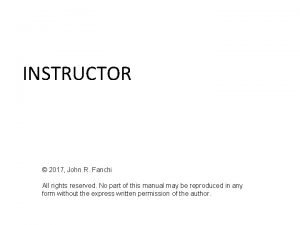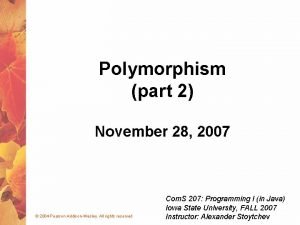4 Integration Copyright Cengage Learning All rights reserved









































- Slides: 41

4 Integration Copyright © Cengage Learning. All rights reserved.

4. 4 The Fundamental Theorem of Calculus Copyright © Cengage Learning. All rights reserved.

Objectives n Evaluate a definite integral using the Fundamental Theorem of Calculus. n Understand use the Mean Value Theorem for Integrals. n Find the average value of a function over a closed interval. n Understand use the Second Fundamental Theorem of Calculus. n Understand use the Net Change Theorem. 3

The Fundamental Theorem of Calculus 4

The Fundamental Theorem of Calculus The two major branches of calculus: differential calculus and integral calculus. At this point, these two problems might seem unrelated—but there is a very close connection. The connection was discovered independently by Isaac Newton and Gottfried Leibniz and is stated in a theorem that is appropriately called the Fundamental Theorem of Calculus. 5

The Fundamental Theorem of Calculus Informally, theorem states that differentiation and (definite) integration are inverse operations, in the same sense that division and multiplication are inverse operations. To see how Newton and Leibniz might have anticipated this relationship, consider the approximations shown in Figure 4. 26. 6 Figure 4. 26

The Fundamental Theorem of Calculus The slope of the tangent line was defined using the quotient Δy/Δx. Similarly, the area of a region under a curve was defined using the product ΔyΔx. So, at least in the primitive approximation stage, the operations of differentiation and definite integration appear to have an inverse relationship in the same sense that division and multiplication are inverse operations. The Fundamental Theorem of Calculus states that the limit processes preserve this inverse relationship. 7

The Fundamental Theorem of Calculus 8

The Fundamental Theorem of Calculus The following guidelines can help you understand the use of the Fundamental Theorem of Calculus. 9

Example 1 – Evaluating a Definite Integral Evaluate each definite integral. 10

Example 1 – Solution 11

The Mean Value Theorem for Integrals 12

The Mean Value Theorem for Integrals The area of a region under a curve is greater than the area of an inscribed rectangle and less than the area of a circumscribed rectangle. The Mean Value Theorem for Integrals states that somewhere “between” the inscribed and circumscribed rectangles there is a rectangle whose area is precisely equal to the area of the region under the curve, as shown in Figure 4. 29. 13 Figure 4. 29

The Mean Value Theorem for Integrals 14

Average Value of a Function 15

Average Value of a Function The value of f(c) given in the Mean Value Theorem for Integrals is called the average value of f on the interval [a, b]. 16

Average Value of a Function In Figure 4. 31 the area of the region under the graph of f is equal to the area of the rectangle whose height is the average value. Figure 4. 31 17

Average Value of a Function To see why the average value of f is defined in this way, suppose that you partition [a, b] into n subintervals of equal width Δx = (b – a)/n. If ci is any point in the ith subinterval, the arithmetic average (or mean) of the function values at the ci’s is given by By multiplying and dividing by (b – a) you can write the average as 18

Average Value of a Function Finally, taking the limit as produces the average value of f on the interval [a, b] as given in the definition above. 19

Example 4 – Finding the Average Value of a Function Find the average value of f(x) = 3 x 2 – 2 x on the interval [1, 4]. Solution: The average value is given by Figure 4. 32 (See Figure 4. 32. ) 20

The Second Fundamental Theorem of Calculus 21

The Second Fundamental Theorem of Calculus The definite integral of f on the interval [a, b] is defined using the constant b as the upper limit of integration and x as the variable of integration. A slightly different situation may arise in which the variable x is used in the upper limit of integration. To avoid the confusion of using x in two different ways, t is temporarily used as the variable of integration. 22

The Second Fundamental Theorem of Calculus 23

Example 6 – The Definite Integral as a Function Evaluate the function Solution: You could evaluate five different definite integrals, one for each of the given upper limits. However, it is much simpler to fix x (as a constant) temporarily to obtain 24

Example 6 – Solution cont’d Now, using F(x) = sin x, you can obtain the results shown in Figure 4. 34 25

The Second Fundamental Theorem of Calculus The function F(x) as accumulating the area under the curve f(t) = cos t from t = 0 to t = x. For x = 0, the area is 0 and F(0) = 0. For x = π/2, F(π/2) = 1 gives the accumulated area under the cosine curve on the entire interval [0, π/2]. This interpretation of an integral as an accumulation function is used often in applications of integration. 26

The Second Fundamental Theorem of Calculus The derivative of F is the original integrand. That is, This result is generalized in the following theorem, called the Second Fundamental Theorem of Calculus. 27

The Second Fundamental Theorem of Calculus Using the area model for definite integrals, you can view the approximation as saying that the area of the rectangle of height f(x) and width Δx is approximately equal to the area of the region lying between the graph of f and the x-axis on the interval [x, x + Δx], as shown in Figure 4. 35 28

Example 7 – Using the Second Fundamental Theorem of Calculus Evaluate Solution: Note that is continuous on the entire real line. So, using the Second Fundamental Theorem of Calculus, you can write 29

Net Change Theorem 30

Net Change Theorem The Fundamental Theorem of Calculus states that if f is continuous on the closed interval [a, b] and F is an antiderivative of f on [a, b], then But because F'(x) = f(x), this statement can be rewritten as where the quantity F(b) – F(a) represents the net change of F on the interval [a, b]. 31

Net Change Theorem 32

Example 9 – Using the Net Change Theorem A chemical flows into a storage tank at a rate of 180 + 3 t liters per minute, where 0 ≤ t ≤ 60. Find the amount of the chemical that flows into the tank during the first 20 minutes. Solution: Let c(t) be the amount of the chemical in the tank at time t. Then c'(t) represents the rate at which the chemical flows into the tank at time t. 33

Example 9 – Solution cont’d During the first 20 minutes, the amount that flows into the tank is So, the amount that flows into the tank during the first 20 minutes is 4200 liters. 34

Net Change Theorem The velocity of a particle moving along a straight line where s(t) is the position at time t. Then its velocity is v(t) = s'(t) and This definite integral represents the net change in position, or displacement, of the particle. 35

Net Change Theorem When calculating the total distance traveled by the particle, you must consider the intervals where v(t) ≤ 0 and the intervals where v(t) ≥ 0. When v(t) ≤ 0 the particle moves to the left, and when v(t) ≥ 0, the particle moves to the right. To calculate the total distance traveled, integrate the absolute value of velocity |v(t)|. 36

Net Change Theorem So, the displacement of a particle and the total distance traveled by a particle over [a, b] can be written as (see Figure 4. 36). Figure 4. 36 37

Example 10 – Solving a Particle Motion Problem A particle is moving along a line so that its velocity is v(t) = t 3 – 10 t 2 + 29 t – 20 feet per second at time t. a. What is the displacement of the particle on the time interval 1 ≤ t ≤ 5? b. What is the total distance traveled by the particle on the time interval 1 ≤ t ≤ 5? 38

Example 10(a) – Solution By definition, you know that the displacement is So, the particle moves feet to the right. 39

Example 10(b) – Solution cont’d To find the total distance traveled, calculate Using Figure 4. 37 and the fact that v(t) can be factored as (t – 1)(t – 4)(t – 5), you can determine that v(t) ≥ 0 on [1, 4] and on v(t) ≤ 0 on [4, 5]. Figure 4. 37 40

Example 10(b) – Solution cont’d So, the total distance traveled is 41
 Copyright 2015 all rights reserved
Copyright 2015 all rights reserved Copyright © 2015 all rights reserved
Copyright © 2015 all rights reserved Dell all rights reserved copyright 2009
Dell all rights reserved copyright 2009 Copyright © 2018 all rights reserved
Copyright © 2018 all rights reserved Cengage chapter 7
Cengage chapter 7 All rights reserved example
All rights reserved example All rights reserved sentence
All rights reserved sentence Creative commons vs all rights reserved
Creative commons vs all rights reserved Confidential all rights reserved
Confidential all rights reserved Sentinel controlled repetition
Sentinel controlled repetition 2012 pearson education inc
2012 pearson education inc Microsoft corporation. all rights reserved.
Microsoft corporation. all rights reserved. Microsoft corporation. all rights reserved
Microsoft corporation. all rights reserved Microsoft corporation. all rights reserved.
Microsoft corporation. all rights reserved. Pearson education inc. all rights reserved
Pearson education inc. all rights reserved Warning all rights reserved
Warning all rights reserved Siprop
Siprop All rights reserved formula
All rights reserved formula Warning all rights reserved
Warning all rights reserved Confidential all rights reserved
Confidential all rights reserved Microsoft corporation. all rights reserved
Microsoft corporation. all rights reserved 2010 pearson education inc
2010 pearson education inc Gssllc
Gssllc Copyright 2010 pearson education inc
Copyright 2010 pearson education inc 2010 pearson education inc
2010 pearson education inc Confidential all rights reserved
Confidential all rights reserved Airbus deutschland gmbh
Airbus deutschland gmbh R rights reserved
R rights reserved Rights reserved
Rights reserved 2009 delmar cengage learning
2009 delmar cengage learning Chapter 5 the cardiovascular system
Chapter 5 the cardiovascular system Cengage learning heart diagram
Cengage learning heart diagram South-western cengage learning
South-western cengage learning Chapter 13 medical math assignment sheet cengage learning
Chapter 13 medical math assignment sheet cengage learning 2009 delmar cengage learning
2009 delmar cengage learning Cengage learning heart diagram
Cengage learning heart diagram Learning exercises chapter 1 medical terminology
Learning exercises chapter 1 medical terminology Cengage learning australia
Cengage learning australia Graphing tpr
Graphing tpr Cengage learning
Cengage learning Cengage learning
Cengage learning Wadsworth cengage learning
Wadsworth cengage learning

































































